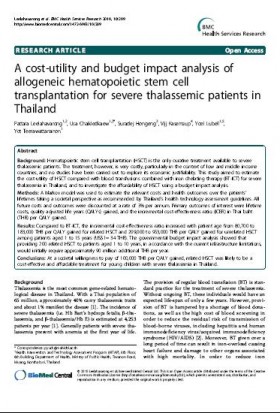This website uses cookies so that we can provide you with the best user experience possible. Cookie information is stored in your browser and performs functions such as recognising you when you return to our website and helping our team to understand which sections of the website you find most interesting and useful.
A cost-utility and budget impact analysis of allogeneic hematopoietic stem cell transplantation for severe thalassemic patients in Thailand. (2010)

Details
A cost-utility and budget impact analysis of allogeneic hematopoietic stem cell transplantation for severe thalassemic patients in Thailand.
Pattara Leelahavarong1,2, Usa Chaikledkaew1,2*, Suradej Hongeng3,
Vijj Kasemsup4, Yoel Lubell1,5, Yot Teerawattananon1
1Health Intervention and Technology Assessment Program (HITAP), Ministry of Public Health, Thailand.
2Division of Social and Administrative Pharmacy, Department of Pharmacy, Faculty of Pharmacy, Mahidol University, Thailand.
3Department of Pediatrics, Faculty of Medicine, Ramathibodi Hospital, Mahidol University, Thailand.
4Community Medicine Center, Faculty of Medicine, Ramathibodi Hospital, Mahidol University, Thailand.
5Mahidol-Oxford Tropical Medicine Research Unit, Faculty of Tropical Medicine, Mahidol University, Thailand.
Backgroud
Hematopoietic stem cell transplantation (HSCT) is the only curative treatment available to severe thalassemic patients. The treatment, however, is very costly, particularly in the context of low and middle income countries, and no studies have been carried out to explore its economic justifiability. This study aimed to estimate the cost-utility of HSCT compared with blood transfusions combined with iron chelating therapy (BT-ICT) for severe thalassemia in Thailand, and to investigate the affordability of HSCT using a budget impact analysis.
Methods
A Markov model was used to estimate the relevant costs and health outcomes over the patients’ lifetimes taking a societal perspective as recommended by Thailand’s health technology assessment guidelines. All future costs and outcomes were discounted at a rate of 3% per annum. Primary outcomes of interest were lifetime costs, quality adjusted life years (QALYs) gained, and the incremental cost-effectiveness ratio (ICER) in Thai baht (THB) per QALY gained.
Results
Compared to BT-ICT, the incremental cost-effectiveness ratio increased with patient age from 80,700 to 183,000 THB per QALY gained for related HSCT and 209,000 to 953,000 THB per QALY gained for unrelated HSCT among patients aged 1 to 15 years (US$1= 34 THB). The governmental budget impact analysis showed that providing 200 related HSCT to patients aged 1 to 10 years, in accordance with the current infrastructure limitations, would initially require approximately 90 million additional THB per year.
Conclusions
At a societal willingness to pay of 100,000 THB per QALY gained, related HSCT was likely to be a cost-effective and affordable treatment for young children with severe thalassemia in Thailand.




